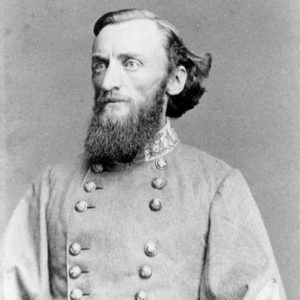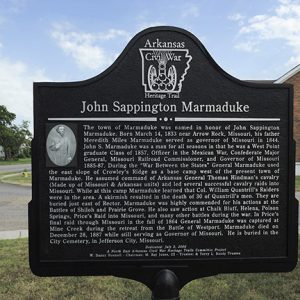calsfoundation@cals.org
John Sappington Marmaduke (1833–1887)
Missouri native John Sappington Marmaduke was a Confederate general who saw action in several Arkansas Civil War campaigns. While he was a capable cavalry leader, he is probably best known for killing fellow general Lucius M. Walker in an 1863 duel concerning disputes about Walker’s actions at the Battle of Helena and the Action at Bayou Meto in 1863. A Greene County town is named in his honor.
John S. Marmaduke was born on March 14, 1833, approximately five miles west of Arrow Rock, Missouri. He was the fourth of ten children born to Lavinia Sappington Marmaduke and Miles Meridith Marmaduke. His father was a successful businessman and politician who held several county offices, was elected lieutenant governor of Missouri in 1840, and, upon the governor’s death in 1844, briefly served as the state’s chief executive. Maramaduke spent his early years learning to farm. However, he also began an extensive education at an early age beginning with local county subscription schools. He also attended Lafayette County’s Chapel Hill Academy and the Masonic College in Lexington, Missouri. Beginning in 1850, he spent two years at Yale University before transferring to Harvard University. He remained at the latter for less than a year, leaving to accept a U.S. Military Academy appointment.
After graduating thirtieth out of thirty-eight in the West Point class of 1857, Marmaduke received his commission as a second lieutenant and was initially assigned to the First United States Mounted Riflemen before being transferred to the Second United States Cavalry. While under the command of Colonel Albert S. Johnston, he participated in the so-called Mormon War of 1857–58 and was stationed at Camp Floyd, Utah. While on duty in the New Mexico Territory in 1861, Marmaduke left for home after receiving erroneous information that Missouri had seceded. Shortly after arriving home, he resigned his commission and organized a company and then accepted a commission as colonel of the First Missouri Rifles of the Missouri State Guard. His initial exposure to Civil War combat came in the June 17, 1861, Battle of Booneville, where untrained troops under his command were routed. Appalled by his troops’ performance, Marmaduke resigned his Missouri commission and traveled to Richmond, Virginia, where he was given the rank of first lieutenant in the Confederate army and assigned to the command of General William J. Hardee at Pittman’s Ferry in Arkansas. Shortly after arriving in northeast Arkansas, he was commissioned a lieutenant colonel of the First Arkansas Battalion of cavalry.
After a brief excursion into Missouri, Hardee’s forces were transferred to Kentucky and Tennessee by early 1862. When the First Arkansas Battalion reached regiment strength, it was designated the Eighteenth Arkansas Infantry Regiment (later the Third Confederate Infantry). Effective on January 1, 1862, Marmaduke was promoted to colonel of a newly organized unit, the Third Confederate, which he led at the Battle of Shiloh in early April. After recovering from wounds he received there, he was promoted to brigadier general and reassigned to Arkansas to organize a cavalry division.
His first action as a brigadier general was at the Battle of Prairie Grove, where he commanded the Fourth Division of the cavalry. Shortly afterward, he led his cavalry on what would be the first of three Missouri raids led by General Sterling Price. He returned to Arkansas, leading the Confederate cavalry in the Action at Fayetteville on April 18, 1863; the Battle of Helena in July; the defense of Little Rock (Pulaski County); and the Action at Pine Bluff on October 25, 1863. It was during the defense of Little Rock, shortly after the Action at Bayou Meto, on August 27, 1863, that a dispute with General L. M. Walker over Walker’s previous actions in combat resulted in a duel that cost Walker his life. Marmaduke was briefly placed under arrest for his participation in the duel.
Late in 1863, Marmaduke once again embarked on a raid into Missouri with General Price. Marmaduke’s cavalry returned to Arkansas to participate in the repulse of Union forces in the 1864 Red River Campaign in southern Arkansas. Marmaduke was commended for his actions at the Engagement at Poison Spring on April 18, 1864.
Shortly after the campaign, Marmaduke once again joined Price for a third and final raid of Missouri, considered by many to be the last significant Confederate operation west of the Mississippi River. The raid, which expanded into Kansas, resulted in several running battles, with Marmaduke being captured during the Battle of Mine Creek in Kansas on October 25. He spent the remainder of the conflict as a prisoner of war and was released in August 1865 from Fort Warren in Boston, Massachusetts. While imprisoned, he was promoted to major general, the last such promotion by the Confederate military.
After the war, Marmaduke went on a tour of Europe before returning to St. Louis, where he briefly worked at a commission house and then in the insurance business. From 1870 to 1874, he served as the editor of the St. Louis Journal of Agriculture. He was then appointed as the secretary of the State Agricultural Board. After attacking railroad business practices, he was appointed to the state’s first railroad commission in 1880. Despite being defeated in a bid for the Democratic nomination for governor in 1880, he remained in the public eye and, in 1884, was elected to the office. He was the first ex-Confederate elected to a major political office in Missouri. As governor, he successfully suppressed railroad strikes in 1885 and 1886 and ultimately signed into law legislation designed to regulate the railroads. He also was active in developing adequate funding for the state’s public schools.
In late 1887, Marmaduke, who never married, contracted pneumonia and died in Jefferson City, Missouri, on December 28. He is buried there in City Cemetery.
For additional information:
Huff, Leo E. “The Last Duel in Arkansas: The Marmaduke-Walker Duel.” Arkansas Historical Quarterly 23 (Spring 1964): 36–49.
Lause, Mark A. Price’s Lost Campaign: The 1864 Invasion of Missouri. Columbia: University of Missouri Press, 2011.
Piston, William Garrett, and John C. Rutherford. “We Gave Them Thunder”: Marmaduke’s Raid and the Civil War in Missouri and Arkansas. Springfield: The Ozarks Studies Institute of Missouri State University, 2021.
Ponder, Jerry. Major General John S. Marmaduke C.S.A. Mason, TX: Ponder Books, 1999.
Sifikis, Stewart. Who Is Who in the Confederacy. Vol. 2. New York: Facts on File, 1988.
Wakelyn, Jon L. Biographical Dictionary of the Confederacy. Westport, CT: Greenwood Press, 1977.
Warner, Ezra J. Generals in Gray: Lives of the Confederate Commanders. Baton Rouge: Louisiana State University Press, 1959.
Mike Polston
CALS Encyclopedia of Arkansas
 Marmaduke (Greene County)
Marmaduke (Greene County) John Marmaduke
John Marmaduke  John Sappington Marmaduke Marker
John Sappington Marmaduke Marker  Lucius Walker
Lucius Walker 




Comments
No comments on this entry yet.